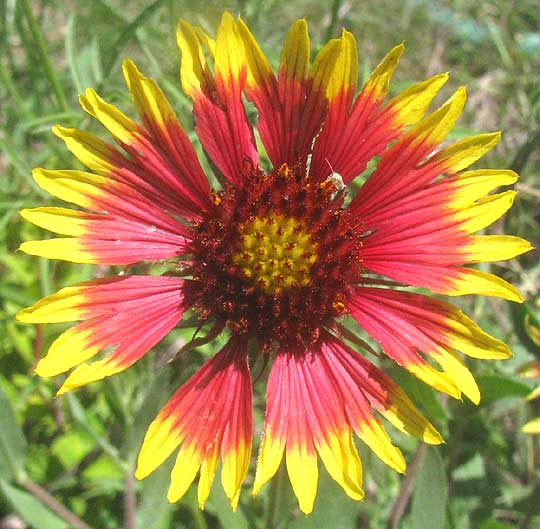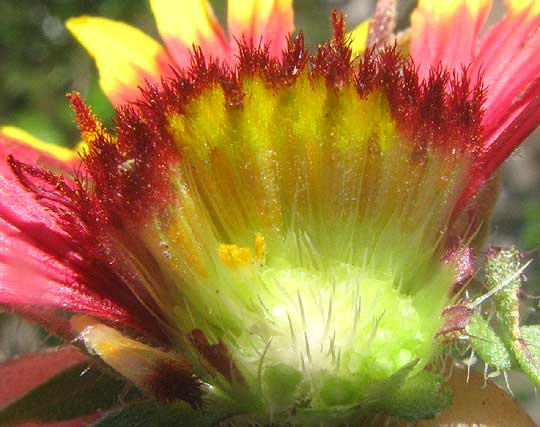Excerpts from Jim Conrad's
Naturalist Newsletter

from the the May 19, 2013 Newsletter issued from the Frio Canyon Nature Education Center in northern Uvalde County, southwestern Texas, on the southern border of the Edwards Plateau; elevation ~1750m (~5750 ft); N29.62°, W99.86°; USA
INDIAN BLANKET
Above you see a common, native, knee-high wildflower now blossoming splendiferously in the grassy area around the cabin, with its gorgeous, two-inch-broad (5cm) heads. A study of just a head in all its glory is shown below:

This is one of the most beautiful and best known of all North American wildflowers, and as such it's known by several common names, including Indian Blanket, Firewheel, Blanket Flower, Sundance and Gaillardia. A member of the Daisy or Composite Family, it's GAILLARDIA PULCHELLA, and judging by its frequency around the cabin wherever water has run off roofs or I've watered ornamental plants, if we'd had normal rainfall this spring the Dry Frio Valley floor would now be resplendent with them, but instead they're just here and there, but even still a riveting presence.
Three Gaillardia species are recorded from Uvalde County, and we had one of them last week, the humble little Pincushion Daisy, Gaillardia suavis, which in our area this season don't even bear ray flowers -- the "petals" radiating from the head's "eye." You might enjoy seeing how the gross appearance of two species in the same genus can be so different by reviewing the Pincushion Daisy at http://www.backyardnature.net/n/h/pincushn.htm.
With such distinctive flower heads as Indian Blanket produces you don't need special field marks to identify it. Still, it's fun to take note of one feature setting this species apart from other Gaillardia species found here. You can see that field mark below:

In that broken-open blossom, do you see the needle-like "setae" poking up from the pale, convex-shaped receptacle from which several disc flowers have been removed? The other two Gaillardia species found here lack such setae.
Traditionally a tea brewed of Indian Blanket roots has been used for gastroenteritis. The root also has been ground into powder, chewed, and applied to the skin for various disorders. Nursing mothers with sore nipples bathed the nipples in tea made from the plant, and sometimes the same tea was used for sore eyes. Indigenous Americans of the Kiowa nation considered the presence of Indian Blanket as good luck.
I'll bet that over the years a million cars traversing our region from northern and western states have pulled to the side of the road so that someone could jump out and uproot some Indian Blankets for planting in the garden back home. Of course the uprooted plants soon died, for Indian Blankets are annuals, only sometimes lasting through mild winters to flower into a second year.
Indian Blanket thrives best on sandy or calcareous soil, even in disturbed places, but mostly in grasslands or open places. It's native to most of arid northern Mexico and the US southern states from Arizona to North Carolina, north in the central area to South Dakota, and here and there farther north elsewhere.